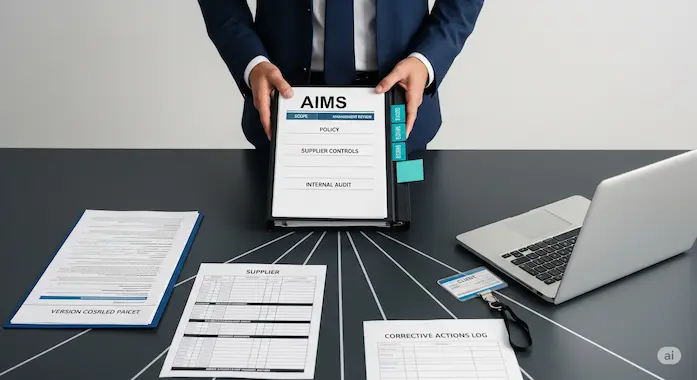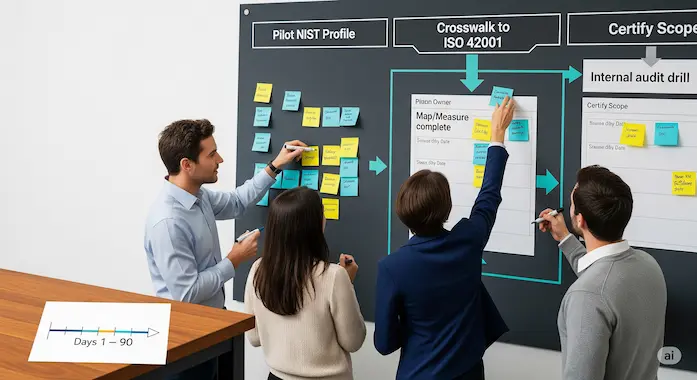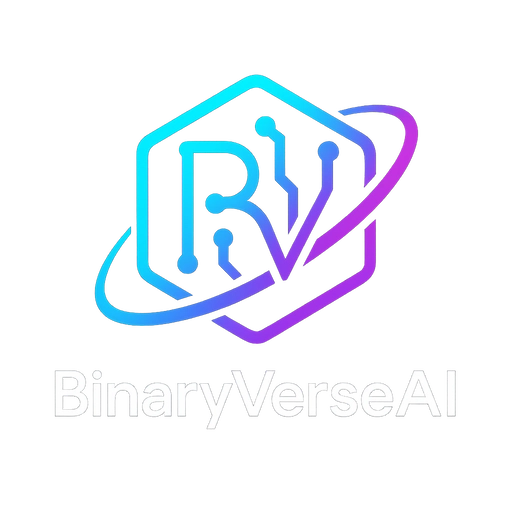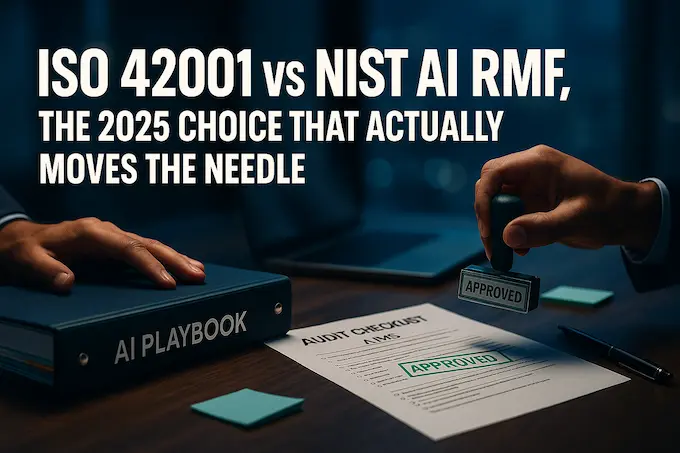Download Your Free Gap Analysis Template
To accelerate this process, we have created a comprehensive NIST to ISO 42001 Gap Analysis Template, available for direct download from our GitHub repository. Click the link to download the Excel file and start your migration planning today.
Introduction
There are two kinds of AI programs. The first kind has posters about ethics on the wall. The second kind can show its homework. If you are deciding between ISO 42001 vs NIST AI RMF, you’re really choosing how you’ll show that homework, to regulators, customers, your board, and your own engineers. One gives you a certifiable management system that an auditor can stamp. The other gives you a flexible, deeply practical playbook that levels up how your teams think, build, and ship. Get the sequence right and you accelerate innovation while staying inside the guardrails. Get it wrong and you burn cycles on paperwork that never reaches production.
This is a field guide from someone who has spent too much time turning abstract “AI governance” into working habits. We’ll cut the marketing fog and give you a repeatable plan you can start Monday morning. We’ll compare ISO 42001 vs NIST AI RMF in plain English, show where each shines, and lay out a migration path that uses both without doubling your workload. Then we’ll close with a crisp call to action so your next model launch is safer, faster, and auditable.
Important Disclaimer: This guide provides a strategic and technical perspective on AI governance frameworks. The information and opinions presented are for educational purposes only and do not constitute legal, financial, or formal audit advice. The author is not a certified auditor or legal counsel. Adopting these frameworks requires significant organizational effort, and following this guide does not guarantee successful implementation or certification. You must consult with qualified professionals to assess your organization’s specific needs and legal obligations.
Table of Contents
1. THE 30-SECOND SNAPSHOT, ISO 42001 VS NIST AI RMF AT A GLANCE
If you only skim one thing, skim this. Think of ISO 42001 as the certifiable rulebook for your AI Management System, and NIST AI RMF as the playbook for how your teams understand and manage AI risk in day-to-day work. Together, they form a pragmatic stack.
Table 1. ISO 42001 vs NIST AI RMF, Executive Summary
| Criterion | ISO/IEC 42001 | NIST AI Risk Management Framework |
|---|---|---|
| Core Idea | Certifiable AI Management System, AIMS | Voluntary, flexible AI risk management playbook |
| Style | Prescriptive, shall statements | Descriptive, outcome based guidance |
| Primary Output | ISO 42001 certification plus documented AIMS | Current and Target NIST Profile, gap and action plan |
| Best Fit | Enterprises that need third-party assurance and repeatable governance | Any org building a culture of AI risk management |
| EU AI Act Link | Aligns with Quality Management System expectations and supports conformity evidence | Maps cleanly to Article 9 risk management system requirements |
| Cost Profile | Standard purchase, training, internal effort, external audit | Free framework, internal effort to operationalize |
| Implementation Motion | Top-down, PDCA, audit ready | Bottom-up to top-down, Govern, Map, Measure, Manage |
When you evaluate ISO 42001 vs NIST AI RMF through a business lens, the winning pattern is simple. Use NIST to build muscle memory across teams. Then codify those muscles in ISO 42001 for external credibility and repeatability. That sequence trims risk and makes audits boring in the best possible way.
2. WHAT THE NIST AI RMF REALLY OFFERS, A PLAYBOOK YOUR TEAMS WILL ACTUALLY USE

The NIST AI Risk Management Framework is the field kit. It gives your engineers, product managers, and risk leads a shared language, then organizes work into four functions that run across the AI lifecycle: Govern, Map, Measure, Manage. In practice, that means you can start small, learn fast, and iterate, which is exactly how healthy AI programs evolve.
- Govern creates the culture and accountability for AI risk management. Policies, decision rights, training, and inventory live here.
- Map frames context. Teams document intended use, stakeholders, data sources, system boundaries, and foreseeable impacts before writing code.
- Measure evaluates risk with qualitative and quantitative methods, from robustness and safety to explainability, privacy, and fairness.
- Manage treats risk, plans responses, and monitors post-deployment behavior, including human-in-the-loop procedures and incident handling.
If you are comparing ISO 42001 vs NIST AI RMF for day-one impact, the NIST approach lands faster. You can pilot one product line, build a NIST Profile for it, then scale what works. That profile becomes your living snapshot of Current versus Target posture, which is gold for prioritization. It is also the friendliest on-ramp for startups and product teams getting their first taste of structured AI risk management.
3. WHAT ISO/IEC 42001 REALLY OFFERS, A MANAGEMENT SYSTEM YOU CAN CERTIFY

ISO 42001 is a management system standard, like ISO 27001 for security or ISO 9001 for quality, but for AI. It expects you to establish, implement, maintain, and continually improve an AI Management System, AIMS. It speaks the language of top management, policies, objectives, documented processes, internal audits, corrective actions, and management review. It plugs into your existing PDCA rhythm, integrates with vendor management, and survives personnel changes. Most importantly, it can be independently certified.
If you are weighing ISO 42001 vs NIST AI RMF, remember that ISO 42001 is not a model checklist. It is an organizational system that proves you have durable controls around the way you build and run AI. That proof matters to procurement teams, regulators, and large customers, especially in regulated sectors.
4. A DEEPER AI FRAMEWORK COMPARISON, WHERE EACH STANDARD SHINES
Table 2. ISO 42001 vs NIST AI RMF, Detailed Comparison
| Dimension | NIST AI RMF | ISO/IEC 42001 |
|---|---|---|
| Purpose | Improve thinking and practice of AI risk management | Establish a certifiable AIMS across the org |
| Scope | Risk controls across projects and lifecycles | Policies, roles, PDCA processes, internal audits, supplier controls |
| Deliverables | NIST Profile, risk register, metrics, playbook integration | AIMS scope and policy, statement of applicability, audit trail, certification |
| Adaptability | High, start anywhere, iterate | High once established, structured change control |
| Culture Impact | Strong bottom-up adoption, shared language | Strong top-down accountability, repeatability, external assurance |
| EU AI Act Compliance | Strong evidence for Article 9 risk management system | Strong evidence for Quality Management System and, once harmonized, presumption of conformity for covered clauses |
| Who Cares Most | Builders and risk owners | Executives, customers, auditors, regulators |
| Cost And Time | Free to adopt, effort in process design and scaling | Costs for standard, training, internal build-out, external audit |
The takeaway for ISO 42001 vs NIST AI RMF is alignment, not rivalry. One tunes your judgment. The other proves you have judgment on a schedule an auditor can test.
5. THE MIGRATION PLAYBOOK, GO FROM NIST TO ISO WITHOUT REDOING THE WORK

Treat this like a product migration, not a paperwork exercise. You can move from NIST to ISO 42001 with leverage if you map once and write twice.
- Step 1, Stand Up NIST Governance In One Lane
Pick a product family, not the entire company. Define ownership, a lightweight AI system inventory, and a decision log. Socialize the four NIST functions. Run a brown-bag on trustworthy AI to set a baseline. If you are asked again about ISO 42001 vs NIST AI RMF, say, “We’re starting with NIST in this lane to build the habits we will certify.” - Step 2, Build A Real NIST Profile
Document Current and Target profiles for that lane. Capture risks and measurements you already do, even if informal. Add what you will measure next quarter. Tie actions to owners and dates. This is your living backlog for AI risk management. - Step 3, Crosswalk To ISO Controls
Run a gap analysis that maps NIST activities to ISO 42001 clauses. Your work in Map and Measure usually fills a surprising amount of the ISO 42001 story. The gaps you’ll see are classic management system gaps, like documented policy, internal audit cadence, supplier controls, and management review artifacts. - Step 4, Write Light, Reuse Heavy
Promote your NIST Profiles, risk registers, and decision logs into formal AIMS documents with the right versioning and approvals. Keep prose short. Point to evidence in your repo. If your teams ask again about ISO 42001 vs NIST AI RMF, remind them that every line of evidence should serve both. - Step 5, Run An Internal Audit Drill
Pick a willing team. Audit a single AI use case end-to-end. Close findings. Record corrective actions. You just rehearsed for certification without hiring a consultant. - Step 6, Freeze Scope And Certify
Define your AIMS scope. Pick the certifying body. Schedule Stage 1 and Stage 2 audits. Ship your strongest product family first. Expand scope yearly. This is how you turn ISO 42001 vs NIST AI RMF into ISO-plus-NIST in practice.
6. HOW THIS STACK HELPS WITH EU AI ACT COMPLIANCE
EU AI Act compliance has two pillars that matter here. First, you need a risk management system for high-risk AI. Second, you need a quality management system that shows your organization can actually run that system.
In the ISO 42001 vs NIST AI RMF pairing, NIST gives you the day-to-day mechanics of risk identification, evaluation, and mitigation that match Article 9 expectations. ISO 42001 provides the organizational scaffolding that aligns with quality management expectations and makes your practice auditable. If and when ISO 42001 is cited as a harmonized standard, certification can grant presumption of conformity for covered requirements. That lowers friction, shortens assessments, and makes third-party checks more predictable.
7. PRACTICAL METRICS THAT MAKE AUDITS BORING
Auditors and regulators do not want a novella. They want a small set of consistent artifacts that show control in action. Here is a minimal kit that serves both sides of ISO 42001 vs NIST AI RMF.
- AI System Inventory with owner, purpose, risk tier, data sources, and model lineage.
- NIST Profile per system with Current and Target outcomes, plus dated action items.
- TEVV Evidence that ties test sets, metrics, and observed limitations to deployment decisions.
- Incident And Override Log that records model fallbacks, human overrides, and outcomes.
- Management Review Notes that show leadership saw both the wins and the warts and decided accordingly.
- Supplier Records for models, data, and tooling, including security and licensing checks.
These artifacts speak the language of AI governance and AI audit without drowning your teams in ceremony. They also give you a clean way to answer the inevitable question, “What changed since last quarter,” which shows up in every serious discussion of ISO 42001 vs NIST AI RMF.
8. A 90-DAY IMPLEMENTATION PLAN YOU CAN LIFT AS IS
- Days 1–10, Decide And Signal
Choose a pilot scope. Assign an AI governance lead with delivery authority. Publish a one-page policy that states how you’ll use NIST today and pursue ISO 42001 certification next. - Days 11–30, Map And Inventory
Build a live inventory of AI systems. Run NIST Map workshops for two high-impact use cases. Capture intended use, data, stakeholders, foreseeable impacts, and guardrails. If your leadership asks again about ISO 42001 vs NIST AI RMF, show the inventory and the first two Maps. - Days 31–60, Measure And Manage
Define your first measurement suite. Focus on validity, robustness, privacy, and fairness that matters for your use cases. Stand up an incident reporting channel. Agree on model rollback and human-in-the-loop triggers. Draft your first NIST Profile with Current and Target states. - Days 61–90, Systematize
Write the AIMS policy, scope, and procedures that wrap the work you already did. Schedule a management review. Perform an internal audit against the pilot scope. Close findings. You now have the skeleton for ISO 42001 certification while fully honoring the spirit of the NIST AI Risk Management Framework.
9. COMMON PITFALLS AND HOW TO DODGE THEM
- Checklist Thinking
Treating ISO 42001 as a document checklist misses the point. The strongest programs keep engineers close to the evidence and route audits through living tools. In the debate over ISO 42001 vs NIST AI RMF, this is where many teams stumble. Use NIST to keep work anchored in reality, then let ISO capture that reality in a sustainable frame. - Over-indexing On Model Metrics
Your model can hit great scores and still cause harm. Context matters. Map before you Measure. This is where the ISO 42001 vs NIST AI RMF pair saves you. NIST forces context, ISO forces accountability for that context. - Forgetting Suppliers
Modern AI stacks are 70 percent suppliers, from foundation models to labeling pipelines. Build supplier oversight into your AIMS now. Nothing will tank a certification faster than missing third-party controls. - No Post-Deployment Plan
Real risks appear in the wild. Monitor. Log overrides. Learn. Feed incidents back into both your NIST Profile and your ISO corrective actions. That loop is the living heart of ISO 42001 vs NIST AI RMF.
10. ANSWERING THE ONE QUESTION THE BOARD WILL ASK
Boards and executive committees have learned that “AI governance” can be either a slide deck or a system that survives turnover. When you present ISO 42001 vs NIST AI RMF to a board, frame it as risk-adjusted velocity. NIST gets you to safer launches faster. ISO locks the wins into a durable operating system. Together, they reduce tail risk, sharpen product decisions, and make EU AI Act compliance less scary.
Give your board three numbers every quarter.
- Percent of AI systems with an up-to-date NIST Profile.
- Mean time to respond to AI incidents.
- Number of closed corrective actions in the AIMS.
Tie incentives to those numbers. Now ISO 42001 vs NIST AI RMF becomes a strategy, not an argument.
11. A PLAIN-ENGLISH CROSSWALK, HOW ACTIVITIES MAP ACROSS
- Inventory And Classification
NIST Govern and Map ask you to list systems and define what they are. ISO expects that list under documented scope and control. Same work, two outputs. This is where ISO 42001 vs NIST AI RMF overlap pays off. - TEVV And Metrics
NIST Measure details the how. ISO wants to see those methods institutionalized, reviewed, and improved. Keep your test plans in version control with traceable approvals. Again, same work, two outputs. - Incidents And Corrective Action
NIST Manage formalizes response and monitoring. ISO names corrective action and management review. Close the loop and cite both in your records. Every time this comes up, remind the team that ISO 42001 vs NIST AI RMF is not double work. It is one loop with two views.
12. BUY VS BUILD, WHERE TO LEAN ON TOOLING
You can do a lot with your existing stack. A repo for living documents, a backlog for actions, a dashboard for metrics, and a ticketing system for incidents. Vendors can help with inventories, model monitoring, and evidence capture, which matters when you scale. The rule of thumb is simple. If a tool reduces context loss between NIST activities and ISO evidence, it pays for itself. This is the most practical way to operationalize ISO 42001 vs NIST AI RMF without recreating the Tower of Babel in spreadsheets.
13. THE HUMAN PIECE, CULTURE, TRAINING, AND DECISION RIGHTS
Policy without training is theater. Training without decision rights is burnout. Put both into your AIMS. Teach the teams the NIST functions with a hands-on example from your product. Publish a short decision matrix for AI go or no-go calls, who signs, and what evidence they review. Update it after each incident review. Doing this well is the difference between arguing about ISO 42001 vs NIST AI RMF and quietly landing both.
14. A SIMPLE LITMUS TEST FOR TRUSTWORTHY AI
Ask three questions for every AI system.
- Who could be harmed, and how would we know early.
- What evidence would convince a skeptical engineer that the system is valid, reliable, secure, explainable, private, and fair enough for the context.
- If something goes wrong, who can stop it, how fast, and what happens next.
Answer these in your NIST Profile. Reflect them in your AIMS. That is the heartbeat of ISO 42001 vs NIST AI RMF in one page.
15. PUTTING IT ALL TOGETHER, YOUR NEXT MOVE
If you’ve read this far, you already know the punchline. The strongest programs do not treat ISO 42001 vs NIST AI RMF as a rivalry. They treat them as a sequence. Start with the NIST AI Risk Management Framework to build habits and language. Turn those habits into an AI Management System and pursue ISO 42001 certification for credibility and scale. Use the same evidence twice. Cut the ceremony, keep the signal, and make your audits boring.
Call to action
Pick one product. In the next ten days, build its NIST Profile. In the next sixty, wrap those practices in an AIMS skeleton. In the next ninety, run an internal audit and lock a date with a certifier. If you want a north star for every conversation about ISO 42001 vs NIST AI RMF, keep it simple. Use NIST to think. Use ISO to prove. Then go build something that deserves the trust you are asking for.
Download Your Free Gap Analysis Template
To accelerate this process, we have created a comprehensive NIST to ISO 42001 Gap Analysis Template, available for direct download from our GitHub repository. Click the link to download the Excel file and start your migration planning today.
1) Is ISO 42001 better than the NIST AI RMF?
Neither is “better”, they solve different jobs. NIST AI RMF is a voluntary, practical playbook for managing AI risk. ISO/IEC 42001 is a certifiable AI management system for organizational assurance. Many teams use NIST first for habits, then ISO 42001 for certification and external trust.
2) Can you get certified for the NIST AI RMF?
Not as an organization. NIST AI RMF is voluntary, NIST does not run a conformity program. You may see private “RMF certificates” for people, those are training credentials, not NIST-issued organizational certification. Certification is typically possible only against standards with explicit requirements, such as ISO management system standards.
3) How does ISO 42001 help with EU AI Act compliance?
The EU AI Act requires a documented risk management system for high risk AI. ISO/IEC 42001 gives you an organization wide AI management system that can support your evidence. EU harmonized AI standards are being developed by CEN and CENELEC, so alignment with 42001 is useful while formal harmonization progresses.
4) What is the difference between ISO 42001 and ISO 27001?
ISO 27001 is for information security management systems, ISMS. ISO 42001 is for AI management systems, AIMS. They complement each other, security vs AI governance, and many organizations run both.
5) What is an AI Management System, AIMS?
Per ISO, an AIMS is the set of policies, roles, and processes an organization uses to establish and improve responsible AI, with audits and continual improvement. ISO/IEC 42001 defines the requirements for setting up and running that system.

